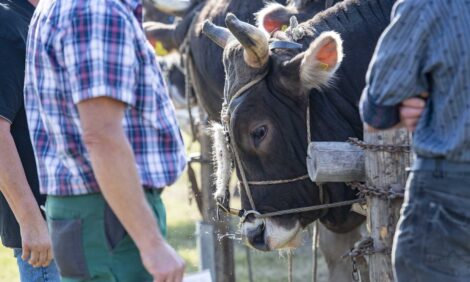



Don’t Forget About the Bulls
By by Bethany Lovaas, DVM. University of Minnesota Beef Team, North Central Research and Outreach Center.As the breeding season approaches, generally everyone is thinking about getting cows and heifers in shape for the breeding season. A nice, tight breeding season results in a nice tight calving season, which generally is the most economical for producers. However, the cow is only half of the equation. Don’t forget about the bulls!!
Bull Breeding Soundness Exams
One of the most important, and often under utilized tools available to beef producers is the bull breeding soundness exam (BSE). A BSE will allow the technician/veterinarian to assess the fertility of a bull based on scrotal circumference, sperm motility, and sperm morphology. The minimum benchmarks that a bull must reach for each of these parameters are:- Sperm motility: 30%
- Normal sperm morphology: 70%
- Scrotal circumference: 30cm (15 mo. of age) to 34 cm (24 mo. of age)
Feet and legs
When selecting herd bulls, emphasis is placed on growth performance, EPD’s, and soundness. These are all good criteria, and no one should try to use a lame or unsound bull for breeding. However, there is nothing wrong with putting a bull on the table for a good foot trim, if he needs it, a month before the start of the breeding season. A bull has to put on a lot of miles, and mount a lot of cows in any given breeding season, and even sound bulls can develop foot problems. If he’s going to hit the ground running, he should have the best set of wheels he can get.Vaccination/deworming
If bulls are housed separately from the cows for most of the year, they are often forgotten and do not receive the same herd health protocol. The herd bulls should be on the same vaccination/deworming schedule as the cows are. Since vaccination schedules vary as much as production systems do, there is no “correct” schedule that everyone should stick with. So, if in doubt, vaccinate and/or deworm your bulls about 2 weeks before they go out to pasture. This will allow for enough time for the vaccine and dewormer to take effect before the bull is exposed to the cows. It also is a good idea to deworm the cowherd before they go out onto the pasture. This will clean out the cows’ systems and limit the parasite burden on the pasture during the spring and early summer.Body condition
When a bull is out on pasture breeding many cows, his mind is only on one thing, and it’s not feed. In the peak of the breeding season, some bulls will breed 6-8 cows a day, and will hardly eat. Therefore, it is very important to make sure a bull goes out on pasture in good condition, so that he has plenty to lose by the time the breeding season is over. Bulls should be in a similar body condition score to replacements heifers, ideally, from 5 to 6.5.Bull: Cow Ratio
There is a lot of variation in producer opinions about how many cows a bull can service during the breeding season. Instead of trying to memorize numbers, try this little rule of thumb: one bull can service as many cows as he is months old, up to fifty months.For example:
- A 15-month-old bull can service 15 cows
- A 24-month-old bull can service 24 cows
- A 50-month-old bull can service 50 cows
Young bulls vs. Older bulls
If a producer has more than one bull, often one bull is older than the other. This helps minimize fighting between the bulls, but the older bull is the smarter, dominant bull, and will get more cows bred. One technique to get around this problem is by rotating your bulls through the cowherd. Start by putting the young bull out with the cows by himself for a couple weeks, then switch the bulls, and send the older bull out with the cows for a couple weeks. This will ensure that the cows are being exposed to the young bull, and will also help him maintain his weight more effectively.Bull rotation also can be a very effective means of stretching your bull power if you need to. By giving each bull 2 weeks on and 2 weeks off, you are giving each a much needed rest, and an opportunity to go out fairly fresh multiple times during the breeding season. This system does create questions about which bull sired which calves. So if you register your calves or report data on your herd, this may not be a good option for you.
Fertility Associated Antigen
Some bulls are inherently more fertile than others. This is due in part to a protein called Fertility Associated Antigen (FAA). The FAA protein is found on the sperm cells of some bulls and results in a higher percentage of sperm capacitation, and therefore a higher rate of fertilization. Studies show that bulls that are FAA positive are about 17% more fertile, and get more cows bred in a 60 day breeding season. There currently is a chute-side test available from ReproTec, Inc. Tucson, AZ that can test for FAA. It takes about 20 minutes per bull and can easily be incorporated into the routine bull breeding soundness exam.Whether they are used as the primary breeding source, or are used for clean up after an AI program, healthy herd bulls are a big part of a successful breeding program. By ensuring that your bulls are in tip-top condition before turnout, you can make great strides in the efficiency and economy of your cowherd.
May 2007



